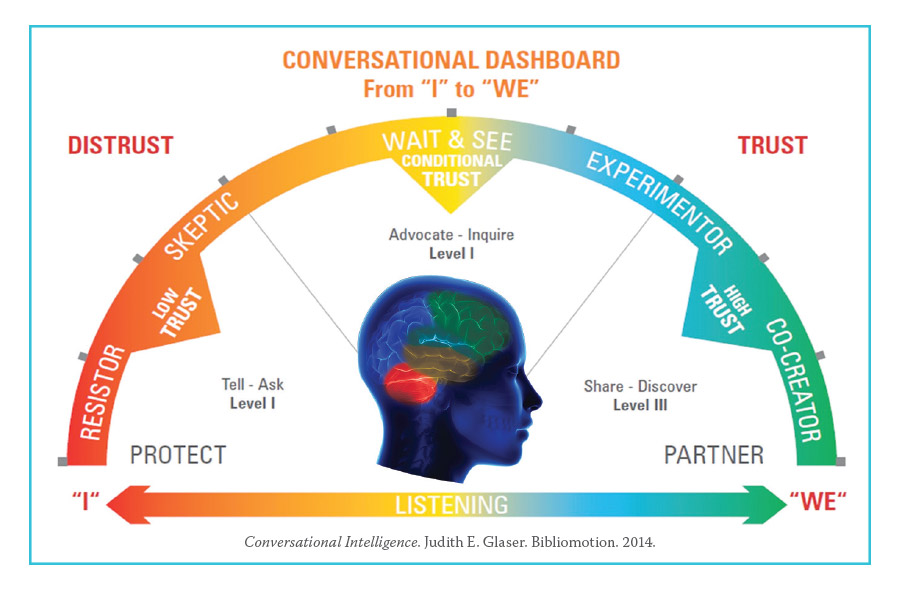
21 Feb Conversational Intelligence
Get to the next level of greatness through quality conversations
“To get to the next level of greatness depends on the quality of the culture, which depends on the quality of relationships, which depends on the quality of conversations. Everything happens through conversations.” – Judith E. Glaser
Judith Glazier is an Anthropopolist, consultant to Fortune 500 companies, CEO of Benchmark Communications Inc and Chairman of The Creating WE Institute. She has recently authored an international best seller, Conversational Intelligence (C-IQ), her research of which has proven how quality conversations have built courageous individuals, strong interactions and relationships, which in turn positively impacted families, communities and organisations.
The oxford dictionary’s definition of conversation is ‘information exchange’, however, as Judith discovered, there is so much more to conversation than this. Below what we see and hear, neurochemistry is activated during conversations that impacts individuals and groups, positively and negatively, influencing the possibility of individuals being open and candid.
So what’s involved when we interact and engage in conversation? What we know of the brain, is that it comprises of many parts, three of which are: the Reptilian brain (the oldest part, responsible for our instinctual reactions); the Limbic brain (where emotions reside and supports our ability to create community with others) and the Neo Cortex (where thought and intellect resides, for both the present and future). However there is a powerful, often overlooked, part of our brain, the Pre Frontal Cortex, which is where creativity, trust and integrity reside. What we also know is that neurochemicals are released in the brain during engagements, which impact how one relates to another in conversation. In particular cortisol (the stress hormone), oxytocin (feel good, bonding hormone) and dopamine (produces adrenalin when energy is increased). In addition, during interactions, an instantaneous energetic pulse resonates at a cellular level (gut impulse) and determines whether one would reject or trust another human or situation in that moment. This resonance is influenced largely by previous prejudices, judgments and experiences.
Judith’s research outlines conversations taking place at three levels :
- The Transactional level confirms what I know, whether another understands me and my reality, and whether or not trust is present
- The next level, Positional Power, where conversations are about persuading, gaining power over another, being right and making another wrong. It’s where ego and conditioning gets in the way of fully receiving another
- The third, Transformational level, is where one is willing to be open, influenced by another and open to an alternative perspective.
When engaging in conversation, various parts of the brain and neurochemicals are activated. For example, at the transactional level, when telling, making statements, holding fixed opinions or trying to convince and dominate, the R-system / Amygdala is activated, Cortisol is produced, which in turn shuts down the Pre-Frontal Cortex. The recipient’s brain perceives rejection, fear, threat and as a consequence, reduces one’s ability to think, empathise and provide honest contributions. At the second level of conversation, the ego steps in and individuals have a strong need to prove themselves right. Dopamine levels are high due to the need for retribution and the resonating negative energy and emotion is mirrored from one individual to another. Here, one’s view of reality is distorted, perspective narrows and courage, insight, trust and empathy is reduced.
When engaging in the third level of conversation, oxytocin is increased, providing a sense of safety, optimism and trust. This in turn facilitates co-creation, engagement and encourages sharing, learning and evolving together. In addition, activity in the front lobe (motor cortex) is enhanced, which links action and language centers of the brain, facilitating longer concentration levels and the ability to process information. It’s here where trust, collaboration and productivity is enhanced. This enables individuals, teams, communities and organisations to perform at their best.
This level of conversation is embraced through being curios and unattached to one’s own agenda. This is supported through asking open questions that encourage creative and authentic contribution from another, for example, ‘’What’s your view?’’, ‘’What do you really want?’’, ‘’Who do I need to be right now to get the best from this interaction?’’
It’s ironic that companies and individual believe that todays challenges are solved by focusing on the future through external interventions. What if, the shift would merely be created from engaging in transformative conversations and interactions now?
Sue Schreuder
